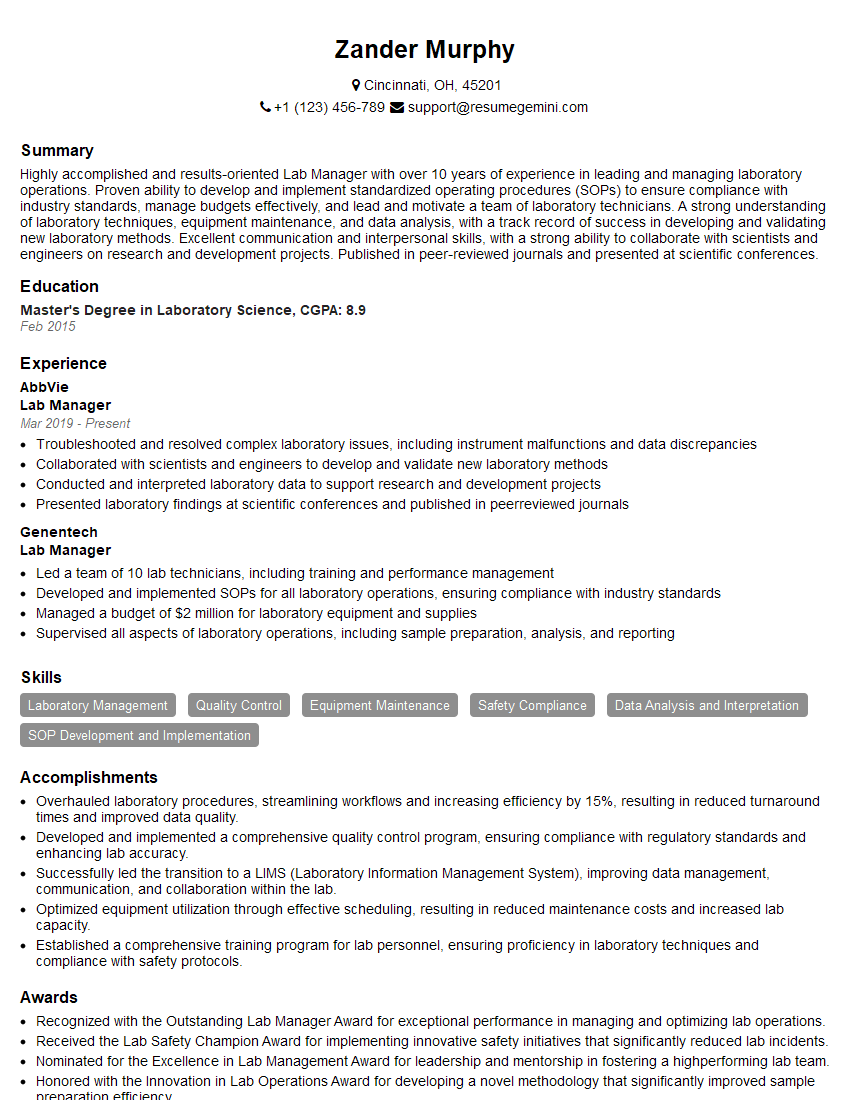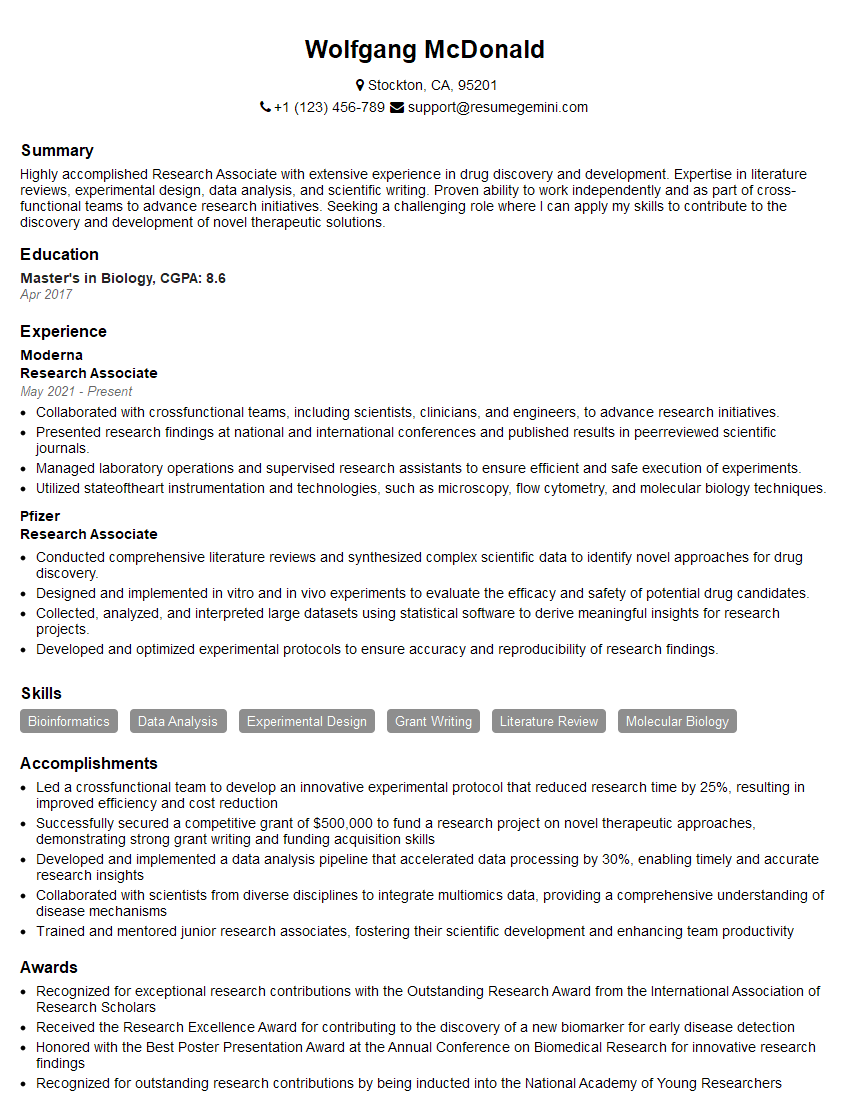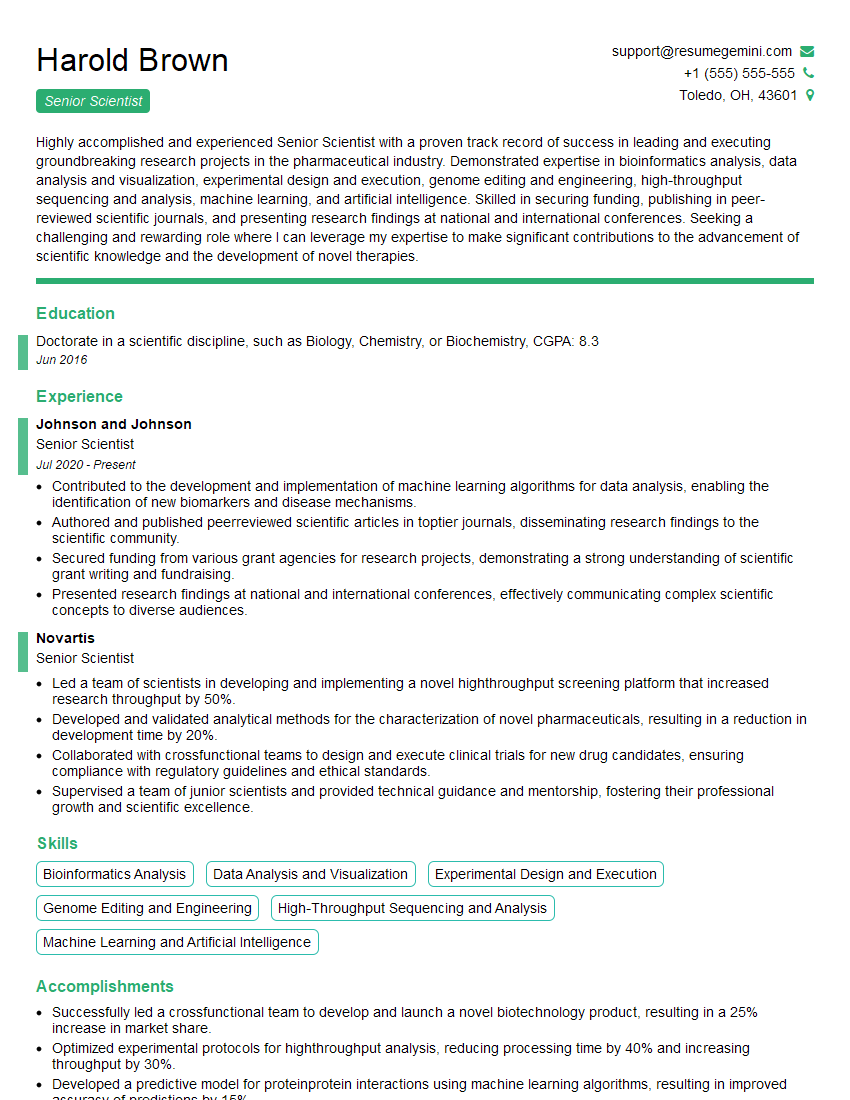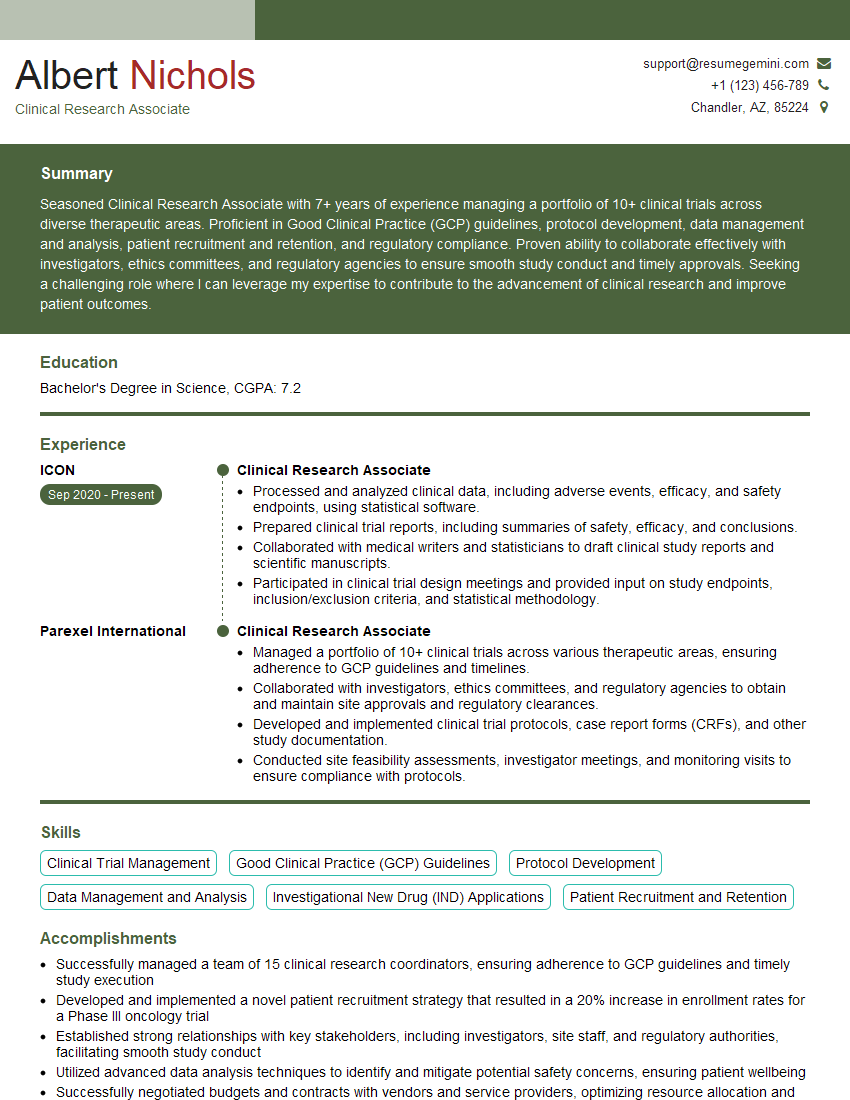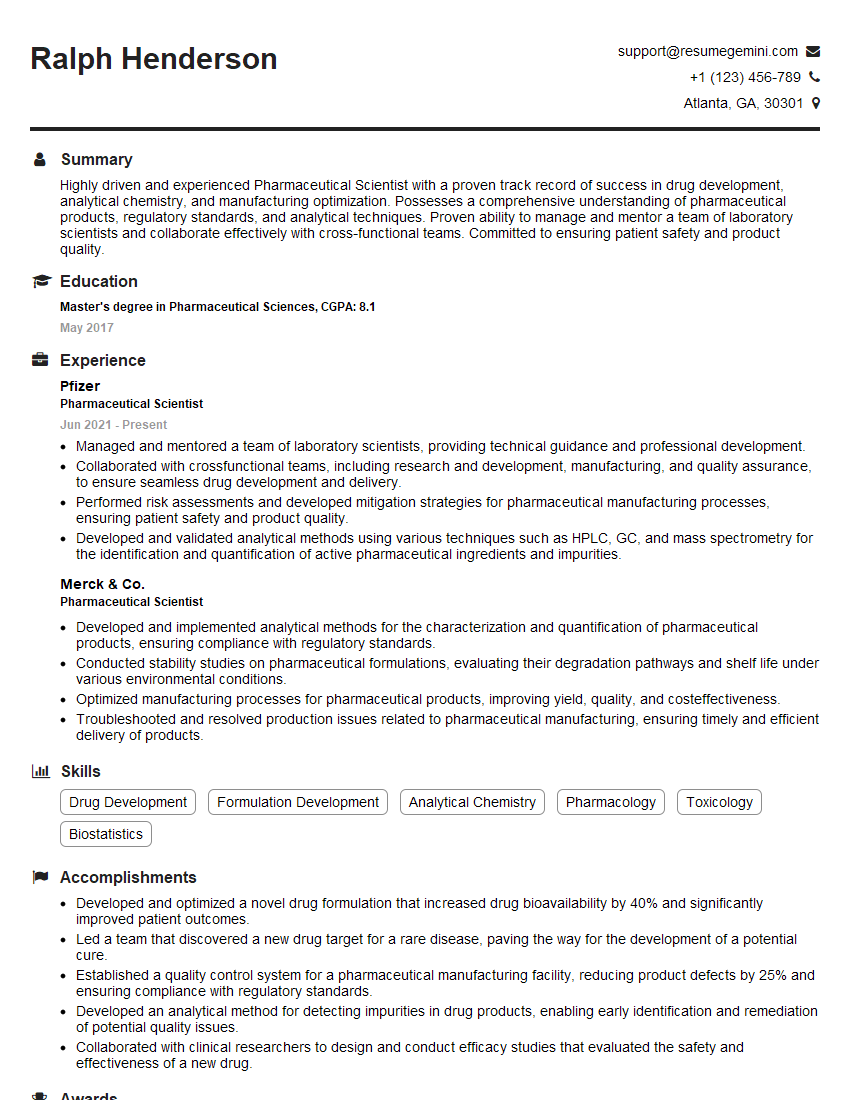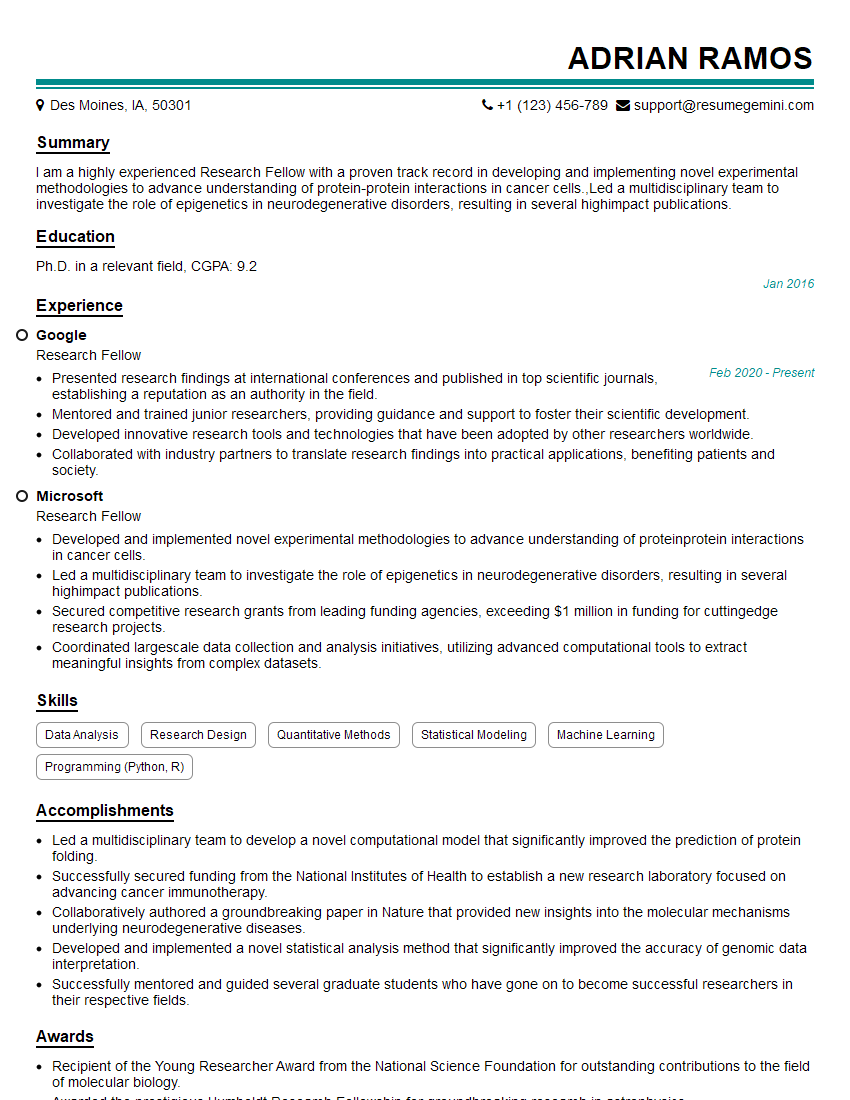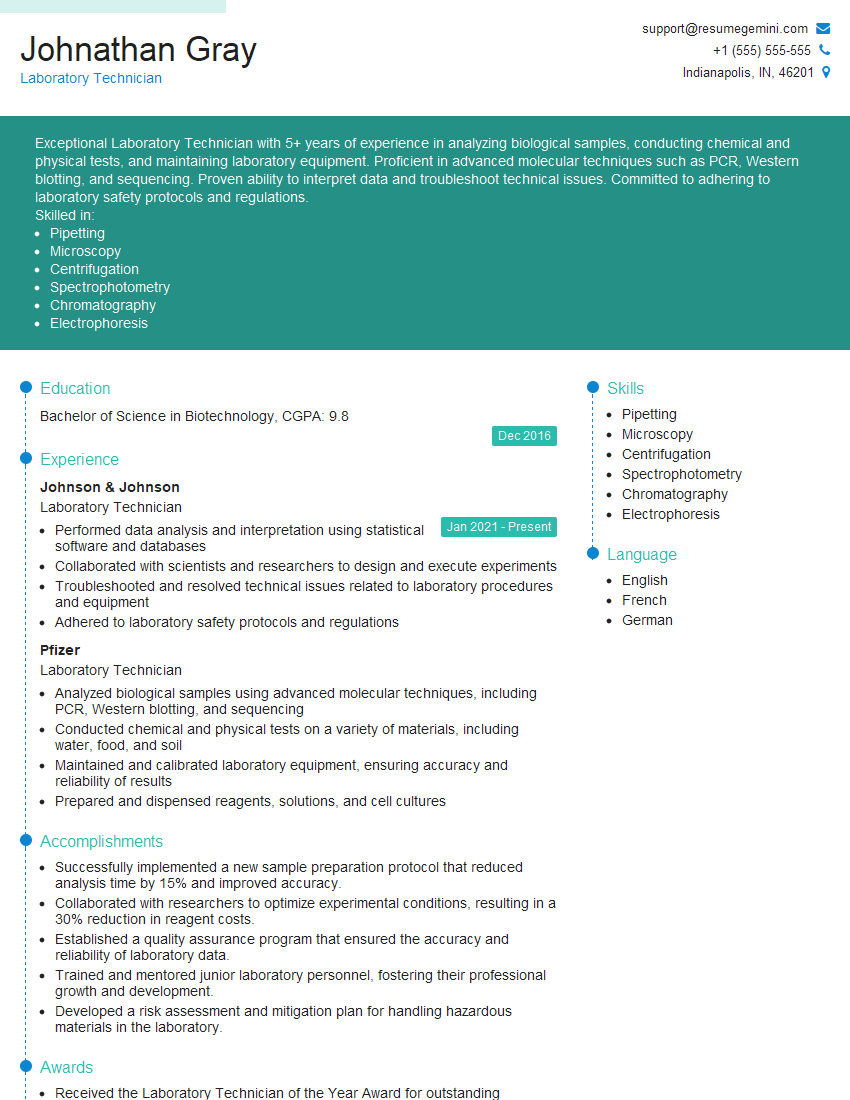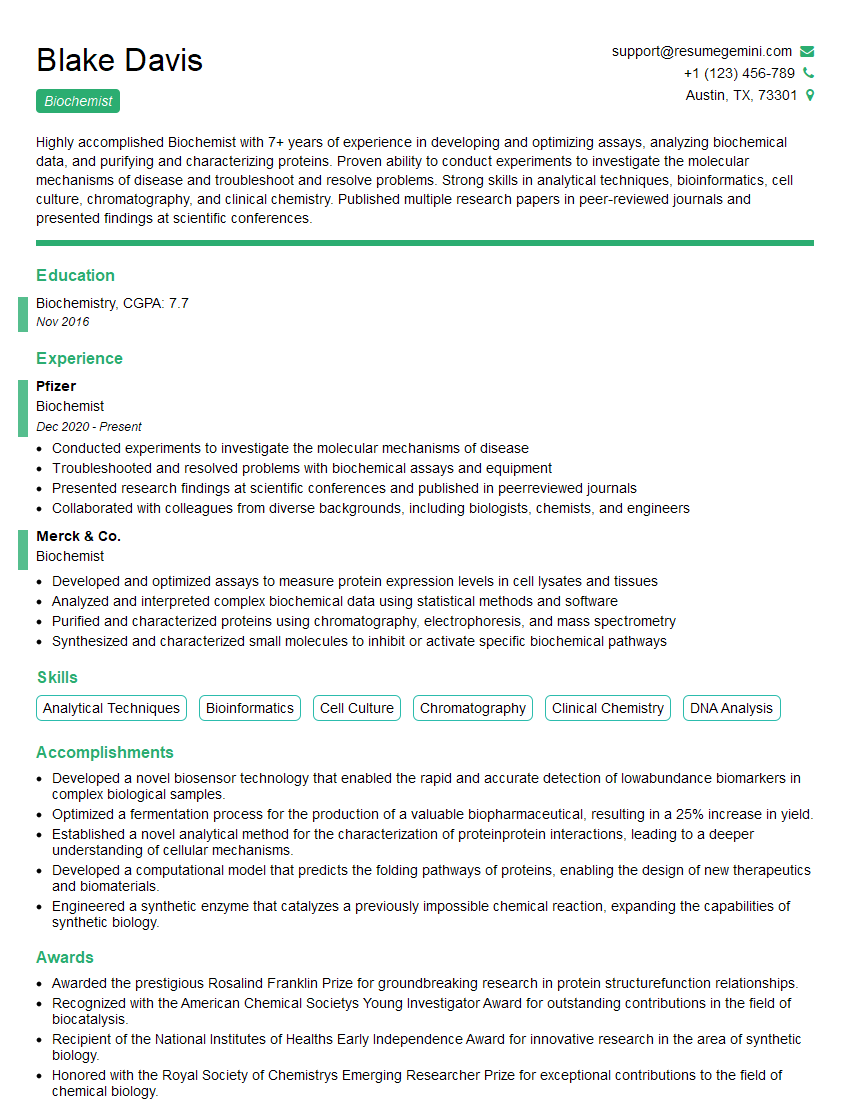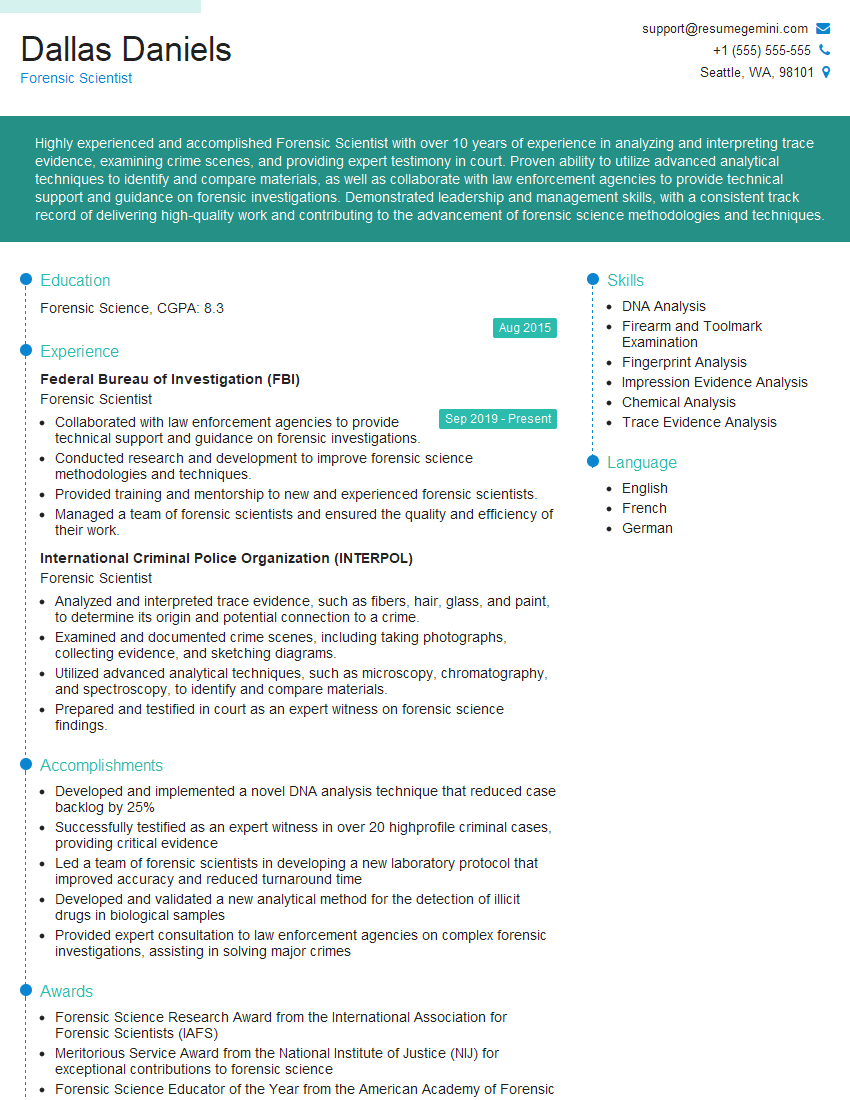Feeling uncertain about what to expect in your upcoming interview? We’ve got you covered! This blog highlights the most important Northern Blotting interview questions and provides actionable advice to help you stand out as the ideal candidate. Let’s pave the way for your success.
Questions Asked in Northern Blotting Interview
Q 1. Describe the principle behind Northern blotting.
Northern blotting is a laboratory technique used to detect specific RNA molecules within a complex mixture of RNA. Think of it like searching for a specific needle in a haystack, but instead of needles and hay, we’re looking for RNA sequences among thousands of others. The principle relies on the ability of a labeled DNA probe, complementary to the target RNA, to hybridize (bind) to its target sequence. This binding is then visualized, allowing researchers to identify and quantify the presence and abundance of the target RNA.
In essence, the process involves separating RNA molecules by size using gel electrophoresis, transferring them to a membrane, and then probing the membrane with a labeled DNA sequence complementary to the target RNA. The probe binds only to the complementary RNA, and its presence can be detected through various methods, typically involving chemiluminescence or autoradiography.
Q 2. What are the key differences between Northern and Southern blotting?
Both Northern and Southern blotting are hybridization techniques used to detect specific nucleic acid sequences, but they differ in their target molecules: Northern blotting targets RNA, while Southern blotting targets DNA. Imagine Southern blotting as analyzing the ‘soil’ (genome), while Northern blotting studies the ‘crops’ (gene expression) growing from it.
- Target: Northern blotting uses RNA as the target molecule, whereas Southern blotting uses DNA.
- Applications: Northern blotting is used to study gene expression, RNA processing, and RNA stability, whereas Southern blotting is used for DNA fingerprinting, genetic mapping, and detecting gene mutations.
- Sample preparation: Northern blotting requires RNA extraction and purification, while Southern blotting requires DNA extraction and digestion with restriction enzymes.
Q 3. Explain the role of each reagent used in Northern blotting (e.g., RNA extraction buffer, formaldehyde, probes).
Each reagent in Northern blotting plays a crucial role in the success of the experiment.
- RNA extraction buffer: This buffer is vital for lysing cells and tissues while protecting RNA from degradation by RNases (enzymes that break down RNA). Different buffers are used depending on the tissue type, but they typically contain components that inhibit RNases and help to solubilize RNA.
- Formaldehyde: This denaturing agent is added to the RNA sample before gel electrophoresis. It causes the RNA to unfold into a linear structure, allowing for accurate size separation during electrophoresis.
- Formaldehyde-containing agarose gel: This gel provides a medium for the electrophoretic separation of RNA molecules based on their size. The formaldehyde ensures the RNA remains denatured during the process.
- Transfer buffer: This buffer facilitates the transfer of RNA from the gel to the membrane. It typically consists of a saline solution that allows the RNA to move from the gel to the membrane by capillary action or using an electric field.
- Probes: These are labeled DNA or RNA sequences that are complementary to the target RNA. They can be labeled with radioactive isotopes or non-radioactive labels such as fluorescent dyes. The probe hybridizes to the target RNA, allowing for its detection. The specificity of the probe determines which RNA molecule is detected.
Q 4. What types of RNA can be detected using Northern blotting?
Northern blotting can detect various types of RNA, including mRNA (messenger RNA), rRNA (ribosomal RNA), tRNA (transfer RNA), and snRNA (small nuclear RNA). This allows researchers to study different aspects of gene expression and RNA metabolism. For example, detecting specific mRNA can reveal information about the expression levels of certain genes, while detecting rRNA can provide insights into ribosomal biogenesis.
Q 5. How is RNA separated in Northern blotting?
RNA is separated in Northern blotting using denaturing gel electrophoresis. A denaturing gel, often containing formaldehyde or other denaturing agents, is used to maintain the RNA in a single-stranded linear form, preventing secondary structure formation that could interfere with accurate size separation. The RNA is then subjected to an electric field, causing it to migrate through the gel matrix. Smaller RNA molecules move faster than larger ones, resulting in size separation. The separated RNA molecules are then visualized using staining agents (like ethidium bromide) or by transferring them to a membrane for hybridization.
Q 6. What are the common methods for transferring RNA from the gel to the membrane?
There are two primary methods for transferring RNA from the gel to the membrane: capillary transfer and electrophoretic transfer (also known as electroblotting).
- Capillary transfer: This method relies on capillary action to draw the buffer containing the RNA from the gel to the membrane. A stack of filter papers, the gel, the membrane, and absorbent pads are arranged to facilitate the upward movement of the buffer.
- Electrophoretic transfer: This method uses an electric field to move the RNA from the gel to the membrane. This is a faster and more efficient method than capillary transfer and yields better results.
Both methods aim to efficiently transfer the RNA from the gel to the membrane, preserving the size separation achieved during electrophoresis and maintaining the RNA for subsequent hybridization.
Q 7. Describe the process of hybridization in Northern blotting.
Hybridization is the crucial step where the labeled probe binds to the complementary target RNA on the membrane. After RNA transfer, the membrane is pre-hybridized in a solution that blocks non-specific binding sites on the membrane, minimizing background noise. Then, the labeled probe is added, and the membrane is incubated under conditions that favor probe-target hybridization (typically high temperature, then a gradual reduction in temperature to allow the strands to anneal). After washing away unbound probe, the location and amount of bound probe (indicating the presence and abundance of the target RNA) are detected, either by autoradiography (for radioactive probes) or chemiluminescence or fluorescence detection (for non-radioactive probes).
Q 8. What are the different types of probes used in Northern blotting and their advantages/disadvantages?
Northern blotting uses probes to detect specific RNA sequences. Several probe types exist, each with its strengths and weaknesses:
- DNA probes: These are relatively inexpensive and easy to synthesize, making them a common choice. However, they can sometimes exhibit cross-hybridization with similar sequences, leading to non-specific signals. Think of it like searching for a word in a document – a shorter word might match multiple places unexpectedly.
- RNA probes: Offering higher specificity than DNA probes due to the inherent RNA structure, they minimize background noise. However, they are more expensive and challenging to synthesize. It’s like having a highly precise search filter to reduce the number of irrelevant results.
- cDNA probes: These are DNA copies of mRNA and offer good specificity. Their generation requires reverse transcription, an additional step increasing complexity and potential for error. They’re like having a specialized index for your document, guiding you directly to the correct section.
- Oligonucleotide probes: These are short, single-stranded DNA or RNA sequences, typically 15-30 nucleotides long. This allows for high specificity and is useful when targeting a very specific part of a transcript. The downside is that they can be more prone to degradation.
Choosing the right probe depends on factors such as the desired specificity, the complexity of the RNA sample, and the available budget. For instance, if you’re working with a complex sample and need high specificity, RNA probes might be preferable despite their higher cost.
Q 9. How is the signal detected in Northern blotting?
Signal detection in Northern blotting typically involves labeling the probe with a detectable molecule. Common detection methods include:
- Radioactive labeling: Historically a common method, using isotopes like 32P. This offers high sensitivity but necessitates handling radioactive materials, requiring specialized safety precautions and equipment.
- Chemiluminescence: Using enzyme-linked probes that generate light upon substrate addition. This offers a safer and easier alternative to radioactive detection with good sensitivity. Think of it like using glow sticks instead of radioactive materials.
- Fluorescence: Utilizing fluorescent dyes or molecules linked to the probe, detected using a fluorescence scanner. This provides high sensitivity and allows for multiplexing (detecting multiple targets simultaneously). It’s like using multiple colored markers for easier identification.
After hybridization, the membrane is washed to remove unbound probes, and the signal is then detected using appropriate imaging equipment, such as a phosphorimager (for radioactive probes), a chemiluminescence imager, or a fluorescence scanner.
Q 10. What are the common challenges encountered during RNA extraction for Northern blotting?
RNA extraction for Northern blotting is a critical step. Challenges include:
- RNA degradation: RNases are ubiquitous enzymes that readily degrade RNA. Even tiny amounts of RNase contamination can significantly impact RNA integrity.
- Low RNA yield: The starting material might not contain sufficient RNA for successful blotting, especially with limited sample availability.
- DNA contamination: DNA contamination can interfere with hybridization and lead to false-positive results. DNA needs to be efficiently removed through DNase treatment.
- Sample purity: Presence of impurities like proteins or polysaccharides can inhibit downstream processes. Thorough purification is essential.
Overcoming these challenges requires meticulous attention to detail, including using RNase-free reagents and equipment, and implementing appropriate purification techniques like phenol-chloroform extraction or column-based purification.
Q 11. How do you ensure RNA integrity during Northern blotting?
Maintaining RNA integrity is paramount for successful Northern blotting. Key strategies include:
- Use of RNase-free reagents and equipment: Always use certified RNase-free materials, and treat all equipment with RNase decontamination solutions.
- Rapid processing of samples: Minimize the time between sample collection and RNA extraction. RNA is very unstable, so speed is crucial.
- Appropriate storage conditions: Store RNA samples at -80°C to prevent degradation.
- Use of RNA stabilization reagents: Reagents like RNAlater can help preserve RNA during sample collection and transport.
- RNA quality assessment: Always assess RNA integrity using methods like agarose gel electrophoresis before proceeding with Northern blotting to detect any degradation.
Imagine RNA as a delicate flower; proper handling and storage are vital to keep it intact and ready for analysis.
Q 12. How can you optimize the hybridization conditions for Northern blotting?
Optimizing hybridization conditions is crucial for successful Northern blotting. This involves fine-tuning parameters such as:
- Temperature: The hybridization temperature should be high enough to ensure specificity (preventing non-specific binding) but low enough to allow for efficient hybridization. This is usually determined empirically, often starting with slightly below the probe’s melting temperature.
- Salt concentration: The salt concentration (e.g., sodium chloride) affects the stringency of hybridization. Higher salt concentrations lead to less stringent conditions and increased non-specific binding. Lower salt concentrations increase stringency and are usually preferred for increased specificity.
- Probe concentration: The optimal probe concentration depends on factors like probe length and specific activity. Too low a concentration reduces signal, while excessive concentration can lead to high background.
- Hybridization time: Sufficient time must be allowed for the probe to hybridize with its target. Longer hybridization times generally improve the signal, but excessively long times can lead to increased background.
Empirical optimization often involves performing test hybridizations with varying conditions to find the optimal combination that yields the strongest specific signal with minimal background.
Q 13. What are the common troubleshooting steps for low signal intensity in Northern blotting?
Low signal intensity in Northern blotting can stem from various issues:
- RNA degradation: Degraded RNA will not hybridize effectively. Verify RNA integrity using an agarose gel.
- Inefficient RNA transfer: Ensure proper transfer of RNA to the membrane. Check for any gaps or imperfections in the transfer.
- Low probe concentration or activity: Use a higher probe concentration or check for adequate labeling efficiency.
- High stringency washing conditions: Reduce the stringency of washing if too harsh.
- Inefficient hybridization conditions: Optimize hybridization temperature, time, and salt concentration.
- Probe specificity issues: Ensure the probe is specific to the target RNA.
Systematic troubleshooting involves systematically investigating each potential problem. A step-wise approach, beginning with RNA quality assessment, then transfer efficiency, and finally hybridization/washing conditions, is generally most effective.
Q 14. How do you quantify the results obtained from Northern blotting?
Quantifying Northern blot results typically involves densitometry, a method that measures the intensity of bands on the blot. This can be done using image analysis software that can calculate the relative abundance of the target RNA compared to a loading control (such as an internal reference gene like GAPDH or β-actin). Normalization to a loading control accounts for variations in RNA loading and transfer efficiency between samples. The intensity of the bands is typically expressed in arbitrary units and compared to other samples or controls.
It’s important to note that Northern blotting provides a semi-quantitative result. Although you can compare relative amounts of mRNA between samples, it’s not as precise as quantitative PCR (qPCR) for precise quantification.
Sophisticated imaging systems and software can also help assess the size of the RNA band, allowing for detection of alternative splicing or RNA degradation products.
Q 15. What are the advantages and limitations of Northern blotting compared to other RNA analysis techniques (e.g., RT-qPCR, microarrays)?
Northern blotting, a technique for detecting specific RNA sequences, offers unique advantages and limitations compared to other RNA analysis methods. While RT-qPCR provides highly sensitive and quantitative data for a specific target, Northern blotting offers a broader view, allowing the visualization of RNA size and the detection of multiple RNA species simultaneously, even unknown ones, in a single experiment. Microarrays, on the other hand, can analyze thousands of genes at once but lack the resolution to detect splice variants or RNA modifications readily apparent in a Northern blot.
- Advantages of Northern Blotting: Size determination of RNA, detection of multiple RNA species simultaneously, ability to detect RNA modifications, relatively straightforward technique.
- Limitations of Northern Blotting: Lower sensitivity than RT-qPCR, less quantitative than RT-qPCR and microarrays, requires relatively large amounts of starting RNA, can be labor-intensive.
For example, if you are investigating a gene suspected of producing multiple splice variants, Northern blotting would be a superior choice compared to RT-qPCR, which would only quantify the total transcript. If a comprehensive gene expression profile is needed, a microarray may be more efficient.
Career Expert Tips:
- Ace those interviews! Prepare effectively by reviewing the Top 50 Most Common Interview Questions on ResumeGemini.
- Navigate your job search with confidence! Explore a wide range of Career Tips on ResumeGemini. Learn about common challenges and recommendations to overcome them.
- Craft the perfect resume! Master the Art of Resume Writing with ResumeGemini’s guide. Showcase your unique qualifications and achievements effectively.
- Don’t miss out on holiday savings! Build your dream resume with ResumeGemini’s ATS optimized templates.
Q 16. Explain the concept of RNA ladder and its importance in Northern blotting.
An RNA ladder is a mixture of RNA molecules of known sizes, similar to a DNA ladder used in gel electrophoresis. It’s crucial in Northern blotting because it serves as a size marker, allowing accurate determination of the size of the target RNA molecule. Imagine trying to measure the length of a piece of string without any ruler; you couldn’t precisely determine its length. The RNA ladder provides that ‘ruler’ for measuring the RNA fragments.
The ladder is loaded alongside the RNA sample in the gel. After electrophoresis and transfer, the bands of the ladder can be visualized, allowing comparison to determine the size of your target RNA based on its position relative to the known sizes of the ladder.
Q 17. Describe different blotting membranes used and when each would be suitable.
Several blotting membranes are used in Northern blotting, each with its own strengths and weaknesses. The choice depends on the type of detection method used (e.g., radioactive, chemiluminescent).
- Nylon membranes (e.g., Nytran, Hybond-N): These are very popular choices, providing high binding capacity and excellent signal strength. They are compatible with both radioactive and chemiluminescent probes. They are generally preferred for their robustness and relatively low background noise.
- Nitrocellulose membranes: These membranes were historically used but are less commonly employed now. Their binding capacity is lower than nylon, resulting in potentially weaker signals. They’re generally used with radioactive probes only.
Choosing the right membrane is crucial for optimizing signal detection. For example, if working with low-abundance RNA and a chemiluminescent probe, a high-capacity nylon membrane would be the preferred choice for maximizing signal strength.
Q 18. How do you control for RNA loading in Northern blotting?
Controlling for RNA loading is essential to ensure that differences in signal intensity reflect differences in RNA levels rather than variations in the amount of RNA loaded in each lane. This is commonly done by including a control RNA, such as a housekeeping gene transcript (e.g., GAPDH, β-actin), or by staining the gel with a dye such as ethidium bromide to visualize the total RNA in each lane before blotting.
The housekeeping gene, expressed at a relatively constant level across different samples, serves as an internal control. Its signal intensity can be used to normalize the signal of the target RNA, correcting for variations in loading. Ethidium bromide staining, while less precise, offers a quick way to visually compare the total RNA quantity loaded in each lane.
Q 19. How can you normalize the results of a Northern blot?
Normalization in Northern blotting is crucial for accurate comparison of RNA levels across different samples. Since loading variations can significantly affect signal intensity, normalization corrects for such inconsistencies. This can be done in a few ways.
- Housekeeping gene normalization: The signal intensity of your target RNA is divided by the signal intensity of a constitutively expressed housekeeping gene (like GAPDH or β-actin) from the same sample. This accounts for loading differences and provides a more accurate reflection of the relative expression levels.
- Total RNA normalization (using ethidium bromide staining): If a housekeeping gene is unavailable or inappropriate, the total RNA loaded in each lane (determined through ethidium bromide staining) can be used to normalize the signal. The signal intensity of the target RNA is then expressed relative to the total RNA in each lane.
This process ensures that you’re comparing apples to apples, and not apples to oranges, when analyzing RNA abundance across different samples.
Q 20. What are the safety precautions needed when working with RNA and radioactive probes?
Working with RNA and radioactive probes necessitates stringent safety precautions due to the inherent risks. RNA is easily degraded by RNases, while radioactive probes pose a radiation hazard.
- RNase prevention: Use RNase-free reagents and glassware; wear gloves at all times; use dedicated equipment; autoclave solutions and materials appropriately.
- Radiation safety: Use appropriate personal protective equipment, including gloves, lab coats, and eye protection; perform procedures in designated radiation safety areas; monitor radiation exposure using dosimeters; dispose of radioactive waste according to institutional guidelines.
- Other general lab safety practices: proper handling of chemicals, sharps disposal, appropriate waste disposal.
Failing to follow these precautions can lead to inaccurate results (RNA degradation) or serious health consequences (radiation exposure).
Q 21. How would you troubleshoot high background signal in a Northern blot?
High background signal in a Northern blot can result from several factors, leading to weak or obscured target bands. Troubleshooting involves systematic investigation of the process.
- Membrane blocking: Insufficient blocking can lead to non-specific binding of the probe. Increase blocking time or use a more efficient blocking agent (e.g., higher concentration of blocking buffer).
- Probe concentration: High probe concentration can increase background. Optimize the probe concentration through titration.
- Wash stringency: Insufficient washing steps can leave unbound probe leading to high background. Increase the number or stringency of washes.
- RNA degradation: Degraded RNA can lead to non-specific binding. Ensure RNA integrity using appropriate techniques and avoid RNase contamination.
- Old reagents: Ensure all reagents and buffers are fresh. Old reagents can deteriorate over time, and affect background noise.
Troubleshooting involves a systematic approach. Begin with the simplest solutions (e.g., increasing wash stringency) before moving to more complex issues (e.g., assessing RNA integrity).
Q 22. Describe the role of prehybridization in Northern blotting.
Prehybridization in Northern blotting is a crucial step that prepares the membrane for hybridization with the labeled probe. Think of it as pre-treating the membrane to block any non-specific binding sites. This prevents the probe from sticking to the membrane itself or other RNA molecules non-specifically, leading to a cleaner signal and more accurate results. It involves incubating the membrane in a solution containing a blocking agent, usually denatured salmon sperm DNA or bovine serum albumin (BSA), in a high-salt buffer. This solution saturates the membrane, filling all available sites that aren’t RNA, so the labeled probe only binds to its target sequence. Without prehybridization, your probe would stick to many places other than your target RNA, giving you a very high background signal and making it near impossible to interpret your results.
Q 23. How does the size and sequence of the probe affect the results of a Northern blot?
The size and sequence of the probe are critical determinants of Northern blot success. The sequence needs to be complementary to the target RNA, ideally encompassing a unique region to avoid cross-hybridization with similar sequences. A longer, more specific probe generally yields a stronger, more specific signal, while a short probe might bind to multiple transcripts. The size of the probe also matters. Very small probes can diffuse more readily into the membrane, resulting in potentially better signal strength but also a risk of increased non-specific binding. Larger probes, on the other hand, may have trouble penetrating the membrane or be too inflexible to properly hybridize. The optimum probe size often depends on the nature of the target and the complexity of the RNA population being analyzed. For instance, when searching for a specific isoform of a gene, a longer probe targeting a unique region is preferred over a short one.
Q 24. What is the importance of using RNase-free conditions throughout the Northern blot procedure?
Maintaining RNase-free conditions is paramount throughout a Northern blot because RNases are ubiquitous enzymes that degrade RNA. Even trace amounts of RNases can completely destroy your RNA sample, rendering your experiment useless. Imagine carefully baking a cake and then having a mouse contaminate it—the final product will be ruined! To prevent RNA degradation, all materials (tubes, pipettes, solutions) must be treated to eliminate RNases. This often involves using RNase-free water, autoclaving glassware, using dedicated RNase-free reagents, and wearing gloves to prevent contamination from your skin. RNase inhibitors can also be incorporated into solutions during RNA isolation and subsequent steps. Failure to maintain RNase-free conditions will lead to the disappearance of the RNA you are attempting to detect, resulting in a negative or weak signal, making interpretation of the results impossible.
Q 25. Explain the concept of stripping and reprobing a Northern blot.
Stripping and reprobing a Northern blot allows you to reuse the same blot to detect multiple RNA targets. It’s a cost-effective and time-saving strategy. After the first hybridization and detection, the probe is removed from the membrane via a stripping solution, typically a relatively high pH buffer or a solution containing formamide and SDS, which disrupts the bond between the probe and the target RNA without damaging the RNA itself or the membrane. After a thorough wash and prehybridization again to block non-specific binding sites, the membrane can then be hybridized with a new probe targeting a different RNA sequence. This approach is valuable when investigating the expression of several genes simultaneously. However, you need to carefully choose a stripping method and conditions to guarantee that the previous probe is completely removed without affecting the integrity of the membrane or your RNA sample. It is important to be mindful that some stripping methods can be more stringent than others, which may lead to a weakening of your RNA signal.
Q 26. Describe your experience using different detection methods (e.g., chemiluminescence, autoradiography).
I have extensive experience with both chemiluminescence and autoradiography detection methods in Northern blotting. Chemiluminescence involves using probes labeled with enzymes that generate light upon substrate addition. The light signal is then detected using X-ray film or a chemiluminescence imager. This method is highly sensitive and provides rapid results. On the other hand, autoradiography utilizes probes labeled with radioactive isotopes, which expose X-ray film to generate an image over time. Autoradiography offers extremely high sensitivity but is time-consuming and requires specialized facilities to handle radioactive materials. Each method has its pros and cons. Chemiluminescence is preferred for speed and safety, while autoradiography, despite safety concerns and being more time consuming, can be utilized when higher sensitivity is absolutely required. In my past experience, I have successfully utilized both methodologies to detect various RNA transcripts.
Q 27. How would you design a Northern blot experiment to investigate a specific gene’s expression?
To investigate a specific gene’s expression using Northern blotting, I would start with careful experimental design. First, I would select appropriate RNA isolation methods for the tissue or cell type of interest. RNA quality assessment would be critical here; I would use an RNA integrity number (RIN) assessment to ascertain integrity. Next, I would design a probe specific to the gene of interest. The probe should be of suitable length and ideally target a unique region within the transcript to avoid cross-hybridization. The probe would then be synthesized and labeled. I would then perform RNA electrophoresis and transfer to a membrane, followed by prehybridization and hybridization with the probe. After stringent washes, the signal would be detected using a suitable method (e.g., chemiluminescence or autoradiography). Finally, the intensity of the signal would be quantified using image analysis software. To get a true understanding of gene expression, I would also include a control group alongside my experimental group, as well as using appropriate loading controls. In my past professional experiences, I have followed this approach for multiple projects, ensuring the experiment’s quality and the accurate interpretation of the results.
Q 28. What software or tools are you familiar with for analyzing Northern blot data?
For analyzing Northern blot data, I’m proficient in using several software packages. ImageJ is a powerful, freely available software ideal for quantifying band intensities, which directly relates to the abundance of the target RNA. ImageQuant TL is another software with sophisticated tools for image analysis, including background subtraction and normalization. More advanced software packages like TotalLab Quant provide more advanced analysis capabilities such as automated lane detection and data export to other platforms. The choice of software depends on the complexity of the analysis needed and the availability of resources. For instance, ImageJ is suitable for simple quantifications, while more sophisticated software would be useful for analyzing large datasets and performing statistical analysis on multiple blots.
Key Topics to Learn for Northern Blotting Interview
- RNA Isolation and Quality Assessment: Understanding different RNA extraction methods and techniques for assessing RNA integrity (e.g., RIN value) is crucial. Consider the impact of RNA degradation on results.
- Northern Blot Procedure: Master the steps involved, from RNA separation by electrophoresis to membrane transfer, hybridization, and detection. Be prepared to discuss troubleshooting common issues.
- Probe Design and Synthesis: Understand the principles of probe design, including considerations for specificity and sensitivity. Familiarize yourself with different labeling techniques.
- Data Analysis and Interpretation: Learn to interpret Northern blot results, including identifying target RNA bands, quantifying expression levels, and assessing the quality of the experiment. Be ready to discuss normalization strategies.
- Applications of Northern Blotting: Discuss the practical applications of Northern blotting in various fields, such as gene expression analysis, RNA processing studies, and viral detection. Be prepared to give specific examples.
- Comparison with other techniques: Understand the advantages and disadvantages of Northern blotting compared to other RNA analysis techniques like qPCR and microarrays. When would you choose Northern blotting over other methods?
- Troubleshooting and Problem-solving: Be prepared to discuss common problems encountered during a Northern blot experiment and potential solutions. This demonstrates practical experience and problem-solving skills.
Next Steps
Mastering Northern blotting techniques significantly enhances your value to research teams and demonstrates a strong foundation in molecular biology. This expertise opens doors to exciting career opportunities in academia, industry, and biotechnology. To maximize your chances of securing your dream role, crafting an ATS-friendly resume is essential. ResumeGemini can help you create a professional and impactful resume that highlights your skills and experience effectively. Examples of resumes tailored to Northern Blotting expertise are available through ResumeGemini to guide you.
Explore more articles
Users Rating of Our Blogs
Share Your Experience
We value your feedback! Please rate our content and share your thoughts (optional).
What Readers Say About Our Blog
Live Rent Free!
https://bit.ly/LiveRentFREE
Interesting Article, I liked the depth of knowledge you’ve shared.
Helpful, thanks for sharing.
Hi, I represent a social media marketing agency and liked your blog
Hi, I represent an SEO company that specialises in getting you AI citations and higher rankings on Google. I’d like to offer you a 100% free SEO audit for your website. Would you be interested?
